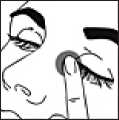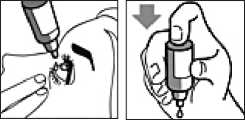Brinzolamide 10 Mg/Ml Eye Drops Suspension

Package leaflet: Information for the user
Brinzolamide 10 mg/ml eye drops, suspension
Brinzolamide
Read all of this leaflet carefully before you start using this medicine because it contains important information for you.
- Keep this leaflet. You may need to read it again.
- If you have any further questions, ask your doctor or pharmacist.
- This medicine has been prescribed for you only. Do not pass it on to others. It may harm them, even if their signs of illness are the same as yours.
- If you get any side effects, talk to your doctor or pharmacist. This includes any possible side effects not listed in this leaflet. See section 4.
What is in this leaflet
1. What Brinzolamide is and what it is used for
2. What you need to know before you use Brinzolamide
3. How to use Brinzolamide
4. Possible side effects
5. How to store Brinzolamide
6. Contents of the pack and other information
1. What Brinzolamide is and what it is used for
Brinzolamide contains brinzolamide, which belongs to a group of medicines called carbonic anhydrase inhibitors.
It reduces pressure within the eye. Brinzolamide eye drops are used to treat high pressure in the eye. This pressure can lead to an illness called glaucoma.
If the pressure in the eye is too high, it can damage your sight.
2. What you need to know before you use Brinzolamide
Do not use Brinzolamide
- if you have severe kidney problems.
- if you are allergic to brinzolamide. or any of the other ingredients of this medicine (listed in section 6).
- if you are allergic to medicines called sulphonamides. Examples include medicines used to treat diabetes and infections and also diuretics (water tablets). Brinzolamide may cause the same allergy.
- if you have too much acidity in your blood (a condition called hyperchloraemic acidosis).
If you have further questions, ask your doctor for advice.
Warnings and precautions
Talk to your doctor or pharmacist before using Brinzolamide:
- if you have kidney or liver problems.
- if you have dry eyes or cornea problems.
- if you are taking other sulphonamide medicines.
Children and adolescents
Brinzolamide is not to be used by infants, children or adolescents under 18 of years of age unless advised by your doctor.
Other medicines and Brinzolamide
Tell your doctor or pharmacist if you are taking, have recently taken or might take any other medicines.
If you are taking another carbonic anhydrase inhibitor (acetazolamide or dorzolamide, see section 1 'What Brinzolamide is and what it is used for'), talk to your doctor.
Pregnancy and breast-feeding
If you are pregnant or breast-feeding, think you may be pregnant or are planning to have a baby, ask your doctor or pharmacist for advice before using this medicine.
Women who may become pregnant are advised to use effective contraception during Brinzolamide treatment. The use of Brinzolamide is not recommended during pregnancy or breast-feeding. Do not use Brinzolamide unless clearly indicated by your doctor.
Ask your doctor or pharmacist for advice before taking any medicine.
Driving and using machines
Do not drive or use machines until your vision is clear. You may find that your vision is blurred for a time just after using Brinzolamide.
Brinzolamide may impair the ability to perform tasks requiring mental alertness and/or physical coordination. If affected, take care when driving or using machines.
Brinzolamide contains benzalkonium chloride
Brinzolamide contains a preservative (benzalkonium chloride) which may cause eye irritation and is known to discolour soft contact lenses. Contact with soft contact lenses should be avoided. If you wear contact lenses you should remove them prior to the application of Brinzolamide and wait at least 15 minutes after instillation of the dose before putting your lenses back in.
3. How to use Brinzolamide
Always use this medicine exactly as your doctor or pharmacist has told you. Check with your doctor or pharmacist if you are not sure.
Only use Brinzolamide for your eyes.
Do not swallow or inject.
The recommended dose is
1 drop in the affected eye or eyes, twice a day - morning and night.
Use this much unless your doctor told you to do something different. Only use Brinzolamide in both eyes if your doctor told you to. Use it for as long as your doctor told you to.
How to use

Picture 1 Picture 2 Picture 3
• Get the Brinzolamide bottle and a mirror.
• Wash your hands
• Shake the bottle and twist off the cap. After the cap is removed, if tamper evident snap collar is loose, remove before using the product.
• Hold the bottle, pointing down, between your thumb and middle finger.
• Tilt your head back. Pull down your eyelid with a clean finger, until there is a 'pocket' between the eyelid and your eye. The drop will go in here (picture 1).
• Bring the bottle tip close to the eye.
Use the mirror if it helps.
• Do not touch your eye or eyelid, surrounding areas or other surfaces with the dropper. It could infect the drops
• Gently press on the base of the bottle to release one drop of Brinzolamide at a time.
• Do not squeeze the bottle: it is
designed so that a gentle press on the bottom is all that it needs (picture 2).
• After using Brinzolamide, press a finger to the corner of your eye, by the nose (picture 3) for at least 1 minute. This helps to stop Brinzolamide getting into the rest of the body.
• If you take drops in both eyes, repeat the steps for your other eye.
• Put the bottle cap back on firmly immediately after use.
• Use up one bottle before opening the next bottle.
If a drop misses your eye, try again.
If you are using other eye drops, leave at least 5 minutes between putting in Brinzolamide and the other drops. Eye ointments should be administered last.
If you use more Brinzolamide than you should
If you get too much in your eyes, rinse it all out with warm water. Do not put in any more drops until it's time for your next regular dose.
If you forget to use Brinzolamide
Use a single drop as soon as you remember, and then go back to your regular routine. Do not use a double dose to make up for a forgotten dose.
If you stop using Brinzolamide
If you stop using Brinzolamide without speaking to your doctor, the pressure in your eye will not be controlled which could lead to loss of sight.
If you have any further questions on the use of this medicine, ask your doctor or pharmacist.
4. Possible side effects
Like all medicines, this medicine can cause side effects, although not everyone gets them.
The following side effects have been seen with brinzolamide.
Common side effects
(may affect up to 1 in 10 people)
- Effects in the eye: blurred vision, eye irritation, eye pain, eye discharge, itchy eye, dry eye, abnormal eye sensation, redness of the eye.
- General side effects: bad taste.
Uncommon side effects
(may affect up to 1 in 100 people)
- Effects in the eye: sensitivity to light, inflammation or infection of the conjunctiva, eye swelling, eyelid itching, redness or swelling, growth on surface of eye, increased pigmentation of the eye, tired eyes, eyelid crusting, or increased tear production.
- General side effects: decreased or reduced heart function, palpitations, decreased heart rate, difficulty breathing, shortness of breath, cough, decreased red blood cell count in blood, increased chlorine level in blood, dizziness, drowsiness, difficulty with memory, depression, nervousness, generalized weakness, fatigue, feeling abnormal, pain, shaking, decreased sex drive, male sexual difficulty, cold symptoms, chest congestion, sinus infection, throat irritation, throat pain, abnormal or decreased sensation in mouth, inflammation of the lining of the oesophagus, abdominal pain, nausea, vomiting, upset stomach, frequent bowel movements, diarrhoea, intestinal gas, digestive disorder, kidney pain, muscle pain, muscle spasms, back pain, nose bleeds, runny nose, stuffy nose, sneezing, rash, abnormal skin sensation, itching, headache, dry mouth.
Rare side effects
(may affect up to 1 in 1,000 people)
- Effects in the eye: corneal swelling, double or reduced vision, abnormal vision, decreased eye sensation, swelling around the eye, increased pressure in eye, damage to the optic nerve.
- General side effects: memory impairment, drowsiness, chest pain, upper respiratory tract congestion, sinus congestion, nasal congestion, dry nose, ringing in ears, hair loss, generalized itching, feeling jittery, irritability, irregular heart rate, body weakness, difficulty sleeping.
Not known (frequency cannot be estimated from the available data):
- Effects in the eye: eyelid abnormality, visual disturbance, corneal disorder, eye allergy, decreased growth or number
of eyelashes.
- General side effects: increased allergic symptoms, decreased sensation, tremor, loss or decrease in taste, decreased blood pressure, increased blood pressure, increased heart rate, joint pain, asthma, pain in extremity, skin redness, inflammation, or itching, abnormal liver blood tests, swelling of the extremities, frequent urination, decreased appetite.
Reporting of side effects
If you get any side effects, talk to your doctor or pharmacist or nurse. This includes any possible side effects not listed in this leaflet. You can also report side effects directly via the Yellow Card Scheme (website: www.mhra.gov.uk/ yellowcard). By reporting side effects you can help provide more information on the safety of this medicine.
5. How to store Brinzolamide
Keep out of the sight and reach of children.
Do not use Brinzolamide after the expiry date which is stated on the bottle and box after "EXP". The expiry date refers to the last day of the month.
This medicine does not require any special storage conditions.
You must throw away a bottle four weeks after you first opened it, to prevent infections. Write down the date you opened each bottle in the space below and in the space on the bottle label and box.
For a pack containing a single bottle, write only one date.
Opened (1):
Opened (2):
Opened (3):
Do not throw away any medicines via wastewater or household waste. Ask your pharmacist how to throw away medicines you no longer use. These measures will help protect the environment.
6. Contents of the pack and other information
What Brinzolamide contains
The active substance is Brinzolamide 10mg/ml.
The other ingredients are: benzalkonium chloride solution 50%, carbomer 974P, disodium edetate, mannitol (E421), Poloxamer 407, water for injection and sodium chloride. Tiny amounts of sodium hydroxide are added to keep acidity levels (pH levels) normal.
What Brinzolamide looks like and the contents of the pack
Brinzolamide is a milky liquid (a suspension) supplied in a pack containing 1, 3 or 6 plastic (dropper container) bottles with a screw cap which includes 5ml white homogenous suspension.
The following pack sizes are available: outer cartons containing 1 x 5ml, 3 x 5ml
Not all pack sizes may be marketed.
Marketing Authorisation Holder and Manufacturer
Marketing Authorisation Holder
Pharmathen S.A.
Dervenakion 6 Pallini 15351 Attiki, Greece
Manufacturer
Pharmathen S.A.
Dervenakion 6 Pallini 15351 Attiki, Greece or
Famar S.A.
Plant A
63 Agiou Dimitriou Street 174 56 Alimos Athens Greece or
Balkanpharma-Razgrad AD 68 Aprilsko vastanie Blvd.,
Razgrad,
7200, Bulgaria
Distributed by:
Aspire Pharma Ltd
Bellamy House
Winton Road, Petersfield
Hampshire
GU323HA
UK
This leaflet was last revised in February 2015.
Aspire
1010189-P1.3